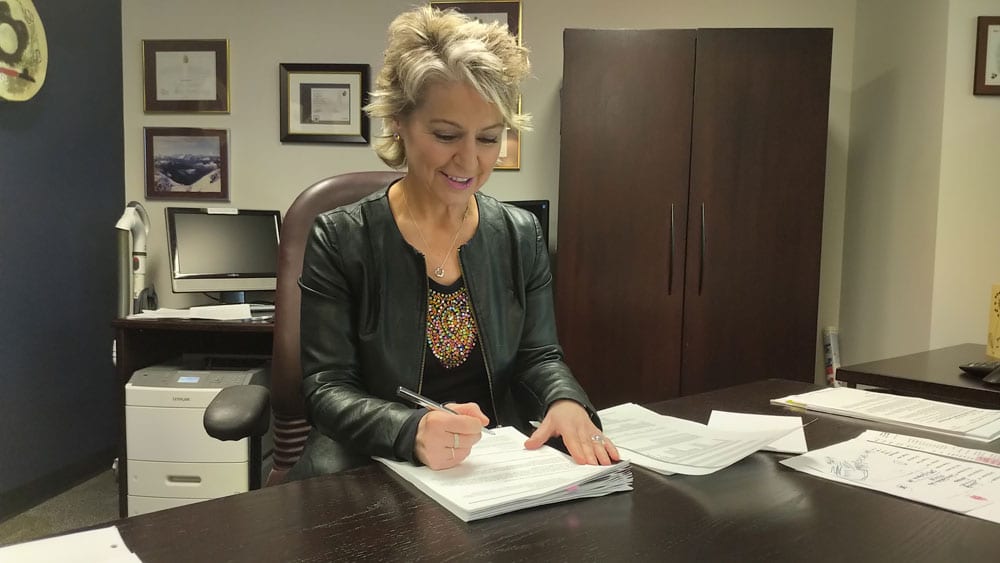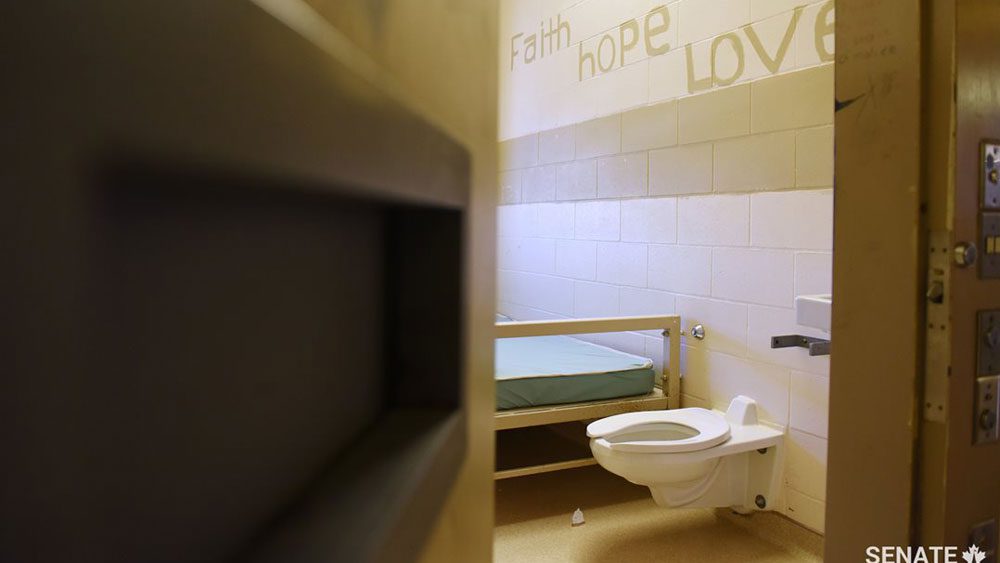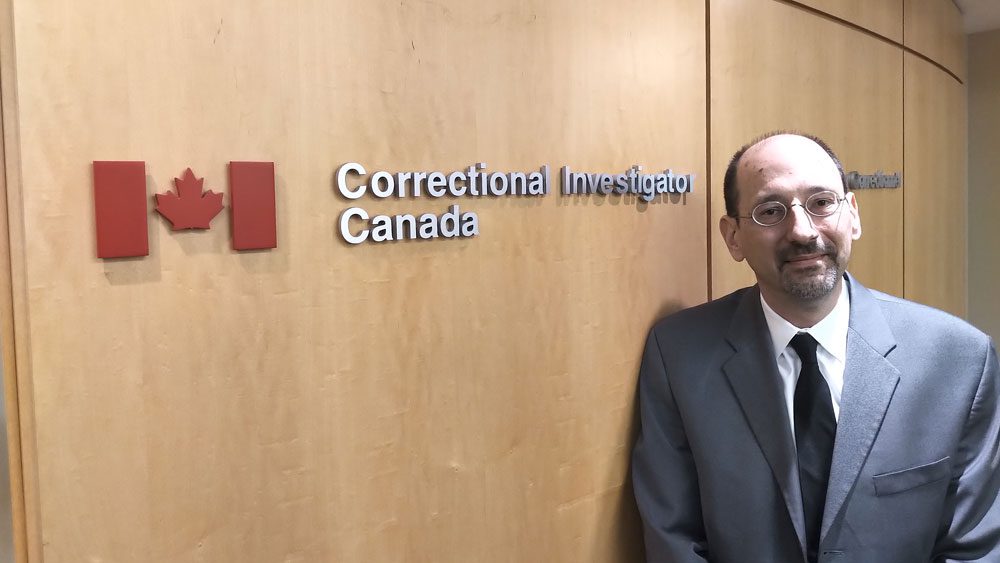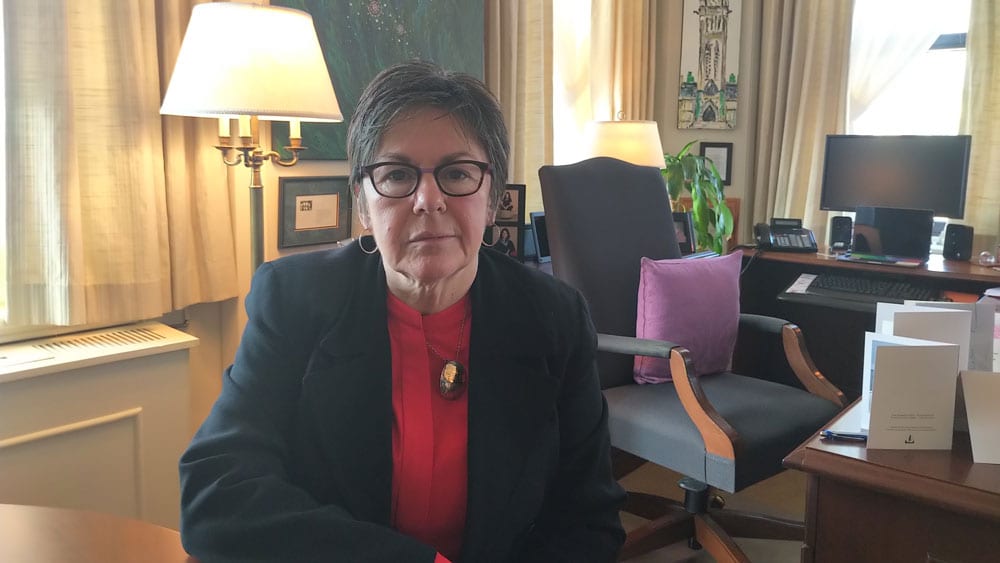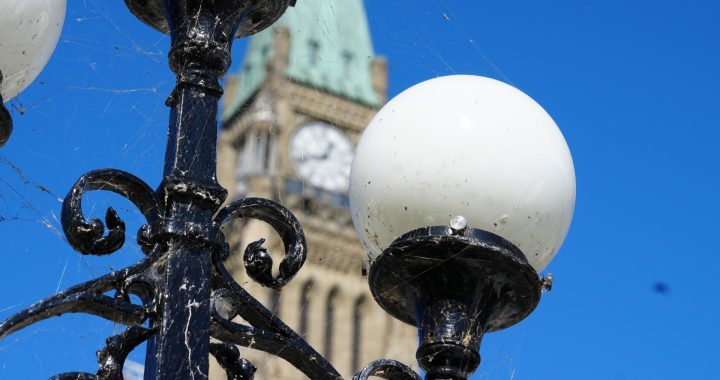

The Senate’s Human Rights Committee is set to release a report soon on Canada’s prisons after a multi-year, fact-finding mission across the country.
If the interim report is any indication, there are issues facing the corrections system the Senate says need addressing.
“Throughout its study, the committee has become aware of a wide range of challenges faced by federally-sentenced persons,” the report states. “The committee was troubled by the frequency and consistency with which these issues were raised.
“The stories shared by federally-sentenced persons were similar from one institution to the next and from one region to another.”
The report found that Indigenous offenders, in most categories, fared worse than other inmates.
“Tackling this issue is particularly urgent for federally-sentenced Indigenous and Black persons who are significantly overrepresented in the correctional system,” it said.
(Anne Kelly in her Ottawa office says CSC is spending a lot of time and effort to reduce the overall population of Indigenous people in prison. Photo: Mark Blackburn/APTN)
The person in charge of tackling these issues is Anne Kelly, a career bureaucrat who has worked with Correctional Service Canada (CSC) since 1983 when she was a parole officer.
She says the department has done a lot in terms of helping Indigenous offenders in the recent past.
“We’re certainly investing a lot of time and effort to reduce the overall representation,” she said.
“You can’t do anything about those who are admitted into our custody, but what we can do though is certainly the time they do spend with us is the ensure that they get timely programming and the other thing that we’ve done now is once an offender has successfully completed programming we do an automatic review of their security classification.”
But corrections is now being challenged from a variety of sources to change its ways.
One source is Canada’s Correctional Investigator, the person in charge of keeping track of the organization that keeps people behind bars in this country.
The office has issued report after report, taking the department to task for failing the Indigenous population in prisons.
It’s hard to argue against, in almost every area, First Nation, Métis and Inuit offenders have it worse than others.
Ivan Zinger’s latest report found few changes. In fact, it may go further than others have in the past calling for Corrections Canada to make bold moves to ensure that life improves for Indigenous inmates.
“For federal corrections, the heavy lifting has hardly begun,” Zinger reports. “A bolder direction is clearly required. To address the enormity of the challenge of Indigenous over-incarceration, CSC and the Government of Canada must more fully devolve responsibility, but most of all resources and control, back to Indigenous people.
“In practice, this could entail a reallocation of spending to match the proportion of Indigenous people with a federal sentence.”
(A cell in the Nova Scotia Institution for Women. Photo courtesy: Senate of Canada)
The picture for First Nation, Métis and Inuit people locked behind bars in Canada has only gotten worse since the Correctional Investigator started writing reports in 2009.
Indigenous offenders made up 30 per cent of all admissions to federal custody in 2017-18 compared to 22.5 per cent 10 years earlier, according to the latest report.
From 2009 to 2018 the Indigenous population increased by 42.8 per cent. The total population now stands at 28 per cent of the prison population despite comprising just 4.3 per cent of the overall population.
Indigenous people in prison are most often than not put in segregation – and serve more of their sentence than non-Indigenous offenders.
Kelly claims things are changing.
“What we’ve done that is different now is that we’ve created Aboriginal intervention centres in each of our regions,” she said. “And we have three in the Prairie region because that is where we have the greatest concentration of Indigenous offenders. And what we’ve done there is for medium security Indigenous offenders serving shorter sentences we’ve integrated the intake assessment that we do with the offenders, we ensure that they get timely programming.
“We’ve also integrated an Aboriginal community development officer as part of the team so the Section 84 release planning can start at the beginning of the sentence not just six months before the offender is about to be released. And what we’ve seen is an increase in day parole releases for Indigenous offenders. So I’m really pleased with those results. And we’re hoping there will be a substantial increase in the numbers of discretionary releases for Indigenous offenders.”
Kelly says community support under Section 84 of the Conditional Release Act is going to be one of the keys to keeping the Indigenous population in prisons down.
“The other thing we’re concerned about though is when they’re released they need to have the supports in place because we don’t want them to come back either on suspension or be revoked so we’re also doing work within the community so when they are released – they stay out.”
Community Healing
Not everyone is convinced the plan is enough.
The Senate’s interim report does deliver some praise, including a nod to the operation of the Waskekun Healing Centre for Indigenous men in Saint-Alphonse-Rodriguez, Que., 100 kilometres north of Montreal.
“On the committee’s visit, federally-sentenced Indigenous Peoples spoke highly of their experience at Waseskun,” said the report.
Senators said prisoners told them if not for the healing centre “they would never have reconnected with their Indigenous roots” and be able to continue on their healing journey.
But the committee’s report didn’t find a commitment to healing centres across the country.
Waseskun is one of only nine healing lodges with 22 to 90 beds for a total of 397. There are two in Alberta, and one each in British Columbia, Manitoba, Saskatchewan and Quebec. None in the North or Atlantic Canada. Two are for women and the other seven for men.
With the exception of the Buffalo Sage Wellness House in Edmonton, Alta., – which is a minimum to medium-security prison – all are minimum security.
Read the Senate’s Interim Report here:
Study on the Human Rights of Federally Sentenced Persons
According to the Senate, most Indigenous prisoners can’t take advantage of this community healing method.
“Despite the absence of any legislative requirement to limit the access of prisoners to healing lodges, access is currently limited to men classified at a minimum-security level and to women classified at minimum and occasionally medium security levels,” said its report.
“As a result, the majority of Indigenous men and women are ineligible to serve parts of their sentences at a healing lodge.
And like many other statistics, Indigenous women continue to be at a disadvantage in almost every category – with more in maximum security and more in segregation.
“Indigenous women are also more likely than non-Indigenous women to be classified at maximum security, limiting their ability to benefit from a healing lodge environment.”
Corrections said it is working on better developing its contacts in the community for healing.
“CSC continues to enhance partnerships to create more opportunities for the participation of Indigenous communities in the management of Indigenous offenders,” it said. “This includes the engagement and collaboration between CSC and Indigenous communities on section 81 agreements under the CCRA for Healing Lodges.
“In 2019-20, CSC will receive $2.7 million from federal Budget 2017, and thereafter, CSC will receive $3.7 million annually to fund Indigenous community support for Indigenous offenders.”
Corrections Canada didn’t say how it was going to approach communities.
Assistant Deputy Commissioner of Indigenous Corrections
One of the longest outstanding recommendations from the Office of the Correctional Investigator since the first report was released, is for corrections to create the position of deputy commissioner of Indigenous corrections.
The sole responsibility of the position would be to work in the interests of Indigenous prisoners.
(Correctional Investigator Ivan Zinger says Corrections Canada needs a bold direction to address the challenge of Indigenous over-incarceration. Photo: MarkBlackburn/APTN)
But going back to that first report in 2009, it has never – publicly anyway -been considered.
“I was disappointed that the Service dismissed my recommendation to appoint a Deputy Commissioner for Aboriginal corrections that accompanied the release of the Mann Report,” wrote former correctional investigator Howard Sapers in 2009.
“I was especially puzzled by the reasoning behind the rejection — that it would add unnecessary bureaucracy and cost.”
The attitude at Corrections hasn’t exactly changed.
“For me, it’s really important for me to have Indigenous corrections integrated throughout the system,” said Kelly. “It’s really important because we have Indigenous offenders in all of our institutions.
It was only at the insistence of Public Safety Minister Ralph Goodale, that Corrections Canada undertook a review of its governance structure to determine whether there is a need for the position.
Kelly wouldn’t say whether she was in favour of the position, which is normally handled by a deputy commissioner who gets advice from the Indigenous advisory committee.
“For me it’s again, I – what is critically important it’s everyone responsibility if there was a deputy commission for Indigenous that it doesn’t become one person’s responsibility – everyone is responsible for the results that we are going to achieve in terms of decreasing the number of Indigenous offenders. But my mandate letter calls for instilling in CSC a culture of self reflection and really looking at what works and what doesn’t work and if it doesn’t work maybe we need to try something different.”
Prior to publishing this article, APTN News asked Kelly’s office for one last update on the review.
“Currently, we consider this level of senior management responsibility to be appropriate to provide the leadership required to improve and sustain correctional results for Indigenous offenders by: creating common purpose, mobilizing and engaging stakeholders, and fostering collaboration with Indigenous communities.”
Rates on the rise
When asked on May 10, the CSC didn’t have the total number of Indigenous inmates or how many were listed as minimum, medium or high security. It did not have an update before this story was published.
But many agree, if current trends continue, that the rate of Indigenous offenders receiving a federal sentence is only going to rise.
According to CSC, those entering the penitentiary system are coming from a high-risk background.
“When you look at Indigenous offenders and non-Indigenous offenders, Indigenous offenders tend to be relatively younger – 51 per cent compared to 38 per cent for non-Indigenous,” said Kelly. “There’s also the fact that, especially in the prairie region, they’re part of what we call security threat groups (gangs), so that is something that we have to work on as well.
“And that’s why sometimes because they are younger, and because in terms of the profile, substance abuse is an issue, they tend to be admitted to say maybe more.”
(Senator Kim Pate in her Ottawa office says Canada has taken systems and “Indigenized them instead of decolonized them.” Photo: Mark Blackburn/APTN)
In her former role as executive director of the Association of Elizabeth Fry Societies, Kim Pate has been in prisons across the country meeting with women on the inside.
“We’ve taken systems and Indigenized them instead of decolonized them,” she said. “Corrections will say they can’t control who comes to them, which is partially true, but they certainly can control what they do once they get there.
“They started building healing lodges in the mid-1990s. The first one planned was the one for women it was supposed to be run by the Nekaneet community within 10 years. It’s never been run by the Nekaneet community. It is now a federal penitentiary.”
According to corrections, “requests may be submitted both formally and informally at all levels of the organization, CSC is unable to provide the exact amount of communities who have requested assistance for Section 81.
“That being said, CSC reviews, on an ongoing basis, its needs for additional capacity and a range of opportunities to work with Indigenous communities and partners to respond to the needs of Indigenous offenders.”
Kelly said corrections is modernizing.
“I would say in terms of the system, for Indigenous offenders, in terms of what we offer it’s really a continuum of services right from the intake to release. As I said, the healing plans, the Indigenous-specific programming that we offer – the fact that we have pathways – the fact that we have healing lodges, the fact that we work with Indigenous communities.
“One thing about the Indigenous offender, while they’re with us, we have Elders, we have Aboriginal liaison officers, we have Aboriginal community development officers, Aboriginal community liaison officers – so we have a number of people that work with the Indigenous offender to ensure that they’re safely and successfully integrated back into the community. “



